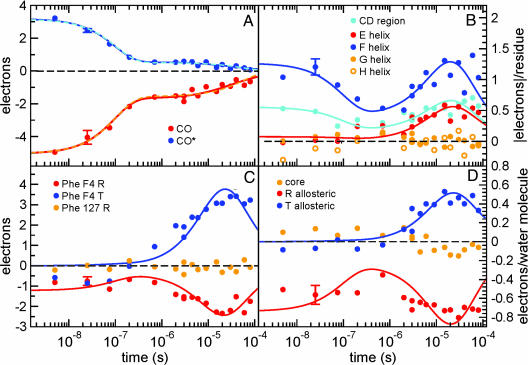Fig. 2.
Integrated difference electron density values, Δρ, as a function of time for several structural moieties. The values are averaged over subunits A and B (see Supporting Materials and Methods for error estimates). (A) Integrated Δρ(t) values for the loss of bound CO (red circles) and the photodissociated CO at the distal pocket docking site (CO*; blue circles). Both features exhibit similar biphasic behavior and are well described by either a sum of an exponential geminate ligand rebinding phase and a bimolecular rebinding phase (solid lines) or a sum of two exponential geminate phases (dashed lines; see Materials and Methods). (B) Integrated absolute values of difference electron densities, |Δρ(t)|, for helices E–H and the CD-loop region (residues 51–63). The nanosecond signal in the F-helix and CD regions corresponds to the early intermediate. Both helices E and F as well as the CD loop exhibit an increase in the signal in the microsecond time domain, simultaneous with the signal associated with a rearrangement of Phe F4 (C) and allosteric water molecules (D). Simultaneous fits of data in B–D by a common exponential function in the microsecond time region are shown as solid lines (see Materials and Methods). The fits take into account ligand rebinding and assume rapid reversal of structural changes upon ligand rebinding. The deviation of the fit from the data in the 30- to 80-μs time region indicates that the reversal of allosteric changes lags behind ligand rebinding. (C) Integrated Δρ(t) values for the Phe F4 ring at the R- and T-state atomic coordinates. Values for the Phe GH3 ring (R-state) are shown for comparison (no signal is observed). (D) Integrated Δρ(t) values for three distinct classes of water molecules at the dimer interface: 9 allosteric R-state, 12 allosteric T-state, and 5 core water molecules. An early (nanosecond) negative density at the allosteric R-state water molecules results from the disruption of this network. The formation of the T-state network of water molecules occurs on the microsecond time scale.

